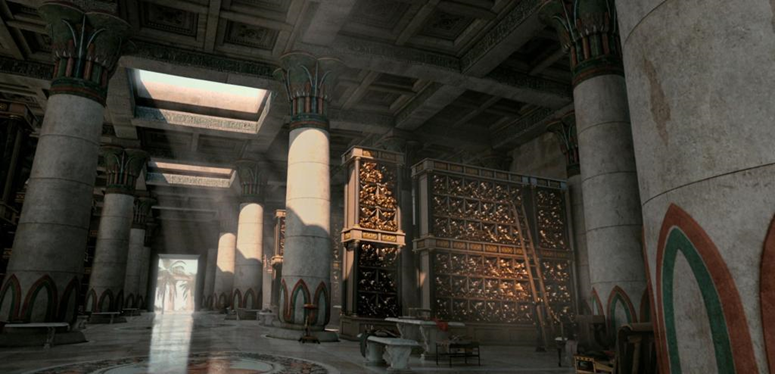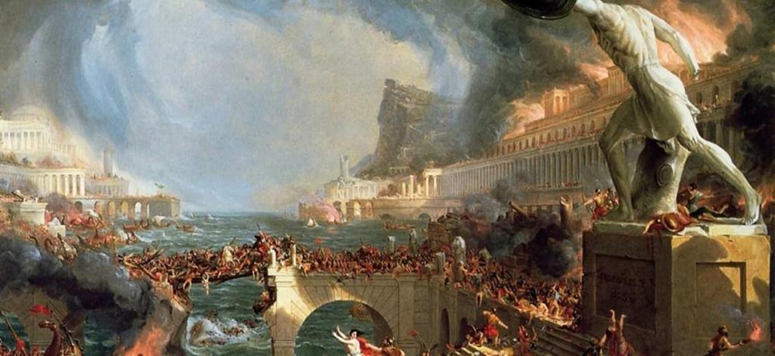?How many times was the Great Library of Alexandria burned

In the beginning.. many centuries before Alexander the Great, the great and beautiful city of Alexandria was under the aspirations of the entire ancient world due to its distinguished strategic location as a major city on the Mediterranean Sea and also as a sea outlet to the inner depth of the kingdom of civilization, science, trade, industry, splendor and beauty. The greatest in history... And before Alexander the Great, it was Ra-Kad, the facility of Ra, or the facility of Ra (which is the ancient Egyptian name for Alexandria). Alexander transformed the city from a huge workshop into a city of beauty, science, libraries, horsemanship, wrestling, theatre, fun, pleasure and trade.

Since the first century BC, and after the ray of Christianity came out of Alexandria to illuminate the world and the first cathedral in all Christian history was built there in the year 49 AD. Founded by St. Mark the Evangelist, the tax of this great city was greed, destruction, killing, arson, and the struggle of religious fanaticism, so many Egyptians fell martyrs during the era of martyrdom (perhaps 1 million martyrs, according to Dr. Mina Abdel-Malik’s article in Al-Ahram newspaper on September 3 2020) and until the early fifth century AD. This great city, with the heroism of its sons and the blood of its Egyptian martyrs, will remain shining in history.

Until the first century AD, the Great Library of Alexandria was the greatest and largest intellectual complex and illumination for humanity. 90% of the number of her books (estimated between 400 thousand to 1 million) contained papyri and volumes of ancient Egyptian temples, 9% Greek books, 1% Babylonian, Persian, Assyrian, Indian and others. The Greeks collected most of the scrolls of papyrus and Egyptian books from the temples they could get and put them in the library. Of course, there are thousands composed of what was stolen, burned, and hidden, and has not appeared to the world until today, and it is believed that the ancient Egyptian records, since the beginning of the formation, in which the secrets, travels, and sciences of the entire universe are still hidden. The library was composed of two huge complexes of papyri and books, one of which was called the Siprapeum (the outer complex) and the other the Musion (the inner complex), as the Roman historian Marcellinus narrated in his book “History” in the year 385 AD.

Fires
Briefly as possible and in order not to get tired of reading, because the accounts are very conflicting, but the Great Library of Alexandria was burned and destroyed as follows during the recorded and known history:
1) As narrated by the Greek-Jewish historian Plutarch, the first to be blamed is Julius Caesar of the Romans in the year 48 BC. When he was chasing his stepson, General Pompey Magnus, the Egyptian fleet of Ptolemy XIII (brother of Queen Cleopatra) besieged him around the port of Alexandria for four months. In order to lift the siege of his fleet, Julius ordered the ships anchored in the port to be burned, and the fire spread to the Egyptian fleet and extended to the Library of Alexandria in February 47 BC. The truth is not known the extent of the damage caused by the fire in the library, but it is believed that Mark Anthony, Cleopatra's lover, had collected nearly 200,000 papyrus, books and manuscripts after the fire to establish and Cleopatra with them and restore the library and call it the Serapis Library.

2) After Cleopatra committed suicide on August 12, 30 BC. With it, Egypt finally fell into the grip of the Romans, bringing to an end very long eras and ages of light, science, and geniuses from the empire that led all humanity and brought it out of darkness. There are 3 other fires that history does not mention except rarely for the library. One of them was in the year 181 AD. During the reign of the Roman Emperor Aurelius and his son Commodus, and again in the year 217 AD. During the rule of the Roman Emperor Macrinus, although the details of the two fires are not clear to history. And a third time during the re-conquest of Alexandria by the Roman Emperor Aurelian after its occupation by rebels from Palmyra, Syria, and during the war another part of the library and its contents were destroyed and burned.

3) In the fourth century A.D., Christian religious fanaticism reached its strongest, atonement was at its peak, and the conflict between religion and what was left of science was horrific, as Edward Gibbons recounted in his book "The Decline and Fall of the Roman Empire." Theophilus, Patriarch of Alexandria, converted what was left of the library (the library of Serapis, which was restored by Cleopatra) into a Christian church in the year 391 AD. To warn of a war against science and to spread the power and extremism of religion. Within 25 years, the library and most of its remaining contents were burned and destroyed by fanatical Christians, among whom was Peter the Reader, who pulled the last great scientist of Egypt and the last geniuses of ancient history, the philosopher Hypatia of Alexandria, off her Egyptian wheel, hit her with stones, smashed her skull, and cut her body. He burned it in a fire whose fuel was the papers of Egyptian and Greek books and papyri in March of the year 415 AD.

4) Most of the foreign references around the world, including Arabic ones as well (such as Al-Maqrizi, Al-Qifti, and Ibn Al-Abri) mention that Caliph Omar Ibn Al-Khattab ordered Amr Ibn Al-Aas to burn the rest of the library in the year 640 AD. After Alexandria became under Arab control because there was something that contradicted the Qur’an. But the truth is, this is never true. The Arabs were eager to learn from the civilization of the Egyptians and their writings, and they actually learned what was left of the Library of Alexandria during their travels to Egypt and also in Persia, and this is certain. Most of the knowledge of the Arabs was from ancient Egypt, then Persia. However, a distinction must be made between the periods of the Islamic caliphate and between the Arabs. The Arab presence in Egypt did not last long and ended before the third century of Hijra (in the year 816 A.D.) and the Muslim Abbasids began to rule Egypt, and from here the disaster began after every Islamic caliphate period overthrows and pounces on the period that preceded it. The famous American astronomer Carl Sagan wrote that: Historian Luciano Canfora wrote: "It was this period of Muslim caliphate rule in which the final end of the Library of Alexandria began." It is clear that the Abbasids, with their successor Abu al-Abbas Abdullah, known as "the butcher" in light of his struggle with the Byzantines, have completely destroyed what remains of the mind and knowledge of the ancient world, even if the events were not clear to history at all, as the references do not record any clear Byzantine attack on the Abbasids in Egypt at that time. This, and also, the hands of the Arabs in Egypt were never white. And books are full of those facts. Historian Luciano Canfora wrote: "It was this period of Muslim caliphate rule in which the final end of the Library of Alexandria began." It is clear that the Abbasids, with their successor Abu al-Abbas Abdullah, known as "the butcher" in light of his struggle with the Byzantines, have completely destroyed what remains of the mind and knowledge of the ancient world, even if the events were not clear to history at all, as the references do not record any clear Byzantine attack on the Abbasids in Egypt at that time. This, and also, the hands of the Arabs in Egypt were never white. And books are full of those facts. In light of his struggle with the Byzantines, what remained of the mind and knowledge of the ancient world was completely terminated, although the events were not clear to history at all, as the references do not record any clear Byzantine attack on the Abbasids in Egypt in that period of time. This, and also, the hands of the Arabs in Egypt were never white. And books are full of those facts. In light of his struggle with the Byzantines, what remained of the mind and knowledge of the ancient world was completely terminated, although the events were not clear to history at all, as the references do not record any clear Byzantine attack on the Abbasids in Egypt in that period of time. This, and also, the hands of the Arabs in Egypt were never white. And books are full of those facts.

conclusion
Although we know that the first Abbasid era was an era of scientific and commercial flourishing and geographical expansion, there is much we do not know about it. The evidence for this is the very great contradiction in foreign and Arabic novels between them and themselves and even their narrators. Archeology has not helped us much so far in understanding what happened, and that inconsistency will remain as long as we rely on novels. After the time of the Abbasids, Egypt extended a long series of burning sciences and libraries and looting the antiquities of civilization until the French-British presence through the Ottoman Empire.
So the Great Library of Alexandria was burned 6 times, not 3 times at all. And through 2500 years in which Egypt and its great civilization were wronged greatly since before history, looted, suppressed, persecuted, stolen, burned and killed a thousand times in the name of greed, fanaticism, conquests, occupations and invasions. The Egyptians were on the verge of extinction from history more than twice. Several mob peoples distorted the Egyptian faith, falsified its writings, stole its sciences and attributed it to them, and Egyptian encyclopedias, papyri, books, inventions and scientific technologies disappeared, turning hair gray due to the horror of its sciences and geniuses. It was stolen by those who stole it, and we know who they are in detail, to reach our time with very little of what we wrote, invented and discovered.
And in my next book, more than that... And we will have another talk about the great Egypt soon.
Source : websites

